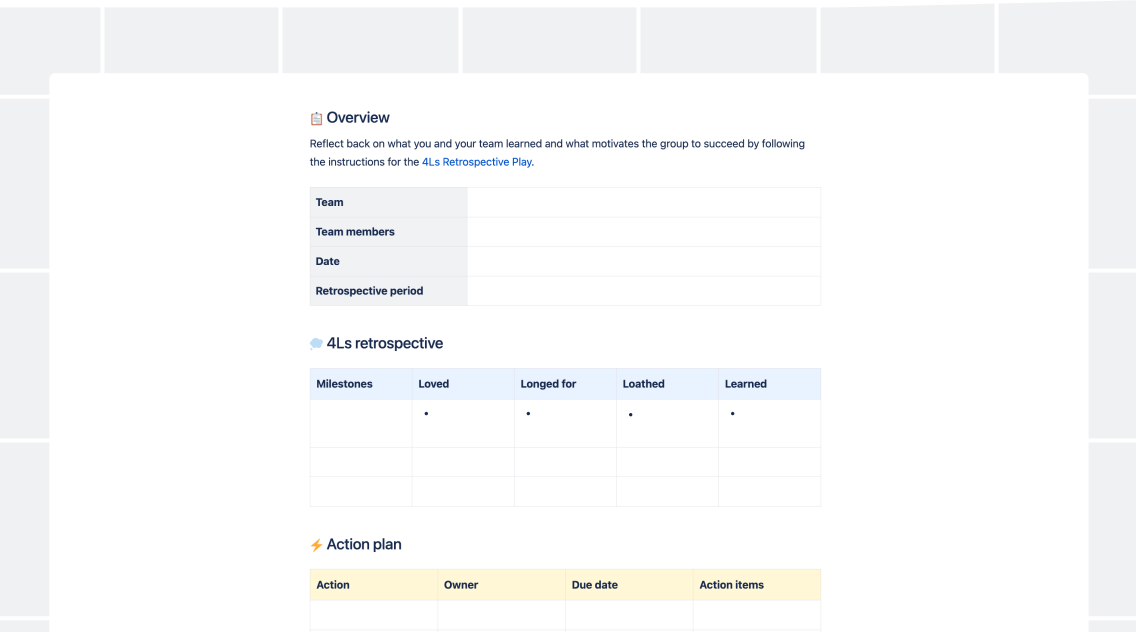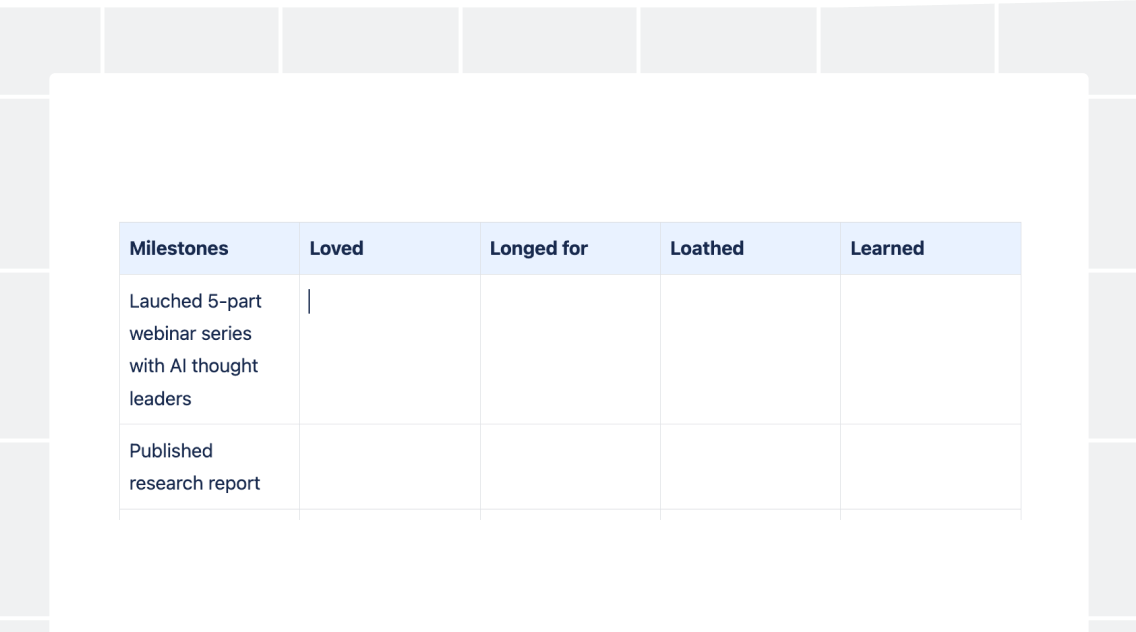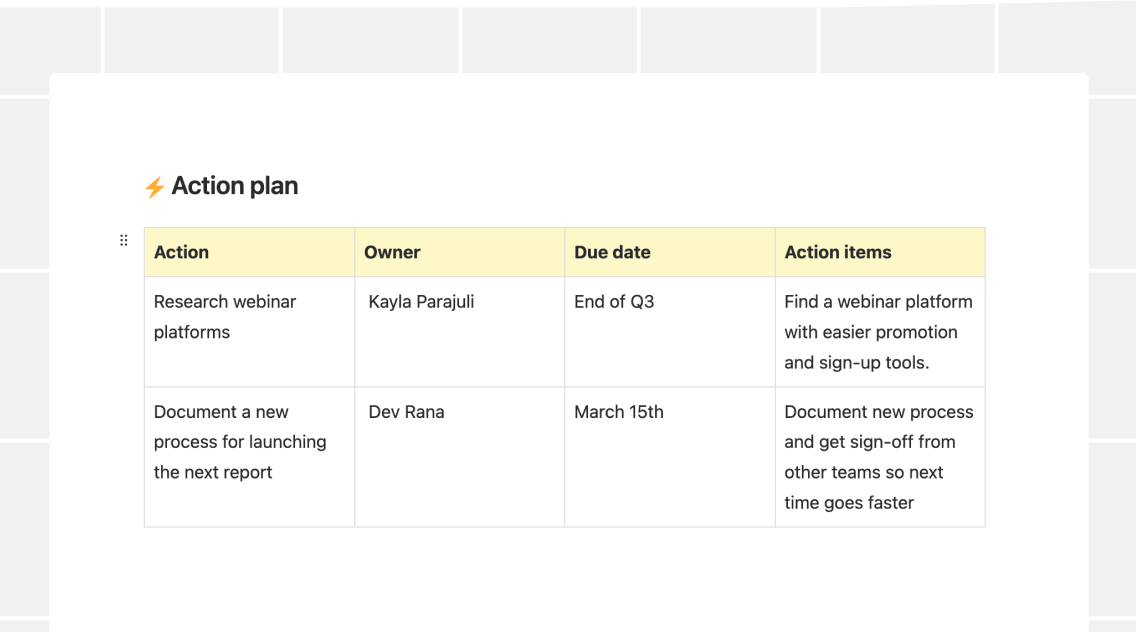4Ls Retrospective
Build a culture of openness and continuous improvement with the 4Ls, a retrospective technique in which team members identify what they loved, loathed, longed for, and learned from a project or sprint of work.

PREP TIME
5m
Run TIME
60m
Persons
2-8
5-second summary
- Reflect on past key milestones.
- Discuss the 4Ls for each milestone.
- Document an action plan to improve.
WHAT YOU WILL NEED
- Video conferencing with screen sharing or meeting space.
- Digital collaboration tool (see templates).
- Optional: physical whiteboard, markers, sticky notes, and timer.
How to run a 4Ls Retrospective
Build a culture of openness and continuous improvement with the 4Ls, a retrospective technique to identify what you loved, loathed, longed for, and learned from a project or sprint of work.
什么是 4L 回顾?
4L 回顾是一种结构化反馈技术,团队使用该技术对已完成的冲刺或项目进行反思,从而改进未来的项目。
4L 代表喜爱、厌恶、渴望和习得。以下是它们各自代表的含义:
- 喜爱:项目中哪些方面进展顺利?这些是团队成员赞赏、喜欢或认为有效的地方。
- 厌恶:是什么让事情变得更糟?有哪些方面缺失或需要改进?这个类别可以找出差距,例如缺少资源、技能或支持,而这些本可以使冲刺更加成功。
- 渴望:团队成员希望他们在冲刺阶段拥有什么?这可以是任何能让工作更高效或更愉快的东西,比如更好的工具、更清晰的需求或更多的时间。
- 习得:团队获得了哪些新知识或技能?这可以是技术知识、更好的沟通方法,也可以是对项目或流程的洞察信息。
为什么要开展 4L 回顾演练?
回顾可以促进持续学习,帮助团队完善工作流和技术,确保今后更有效地交付项目。研究表明,与不经常回顾或没有回顾的团队相比,定期进行回顾的团队的响应速度提高了 24%,质量提升了 42%,并且变化性更小。
何时应使用 4L 回顾?
4L 回顾可以根据不同的团队动态、项目阶段和时间范围进行调整。它并不仅局限于冲刺阶段结束或技术团队;它也可以在项目、发布或重大事件结束时正式使用,或临时用于改进团队会议。
4L 回顾的 3 个好处
- 平衡反馈:4L 框架既包括积极的方面,也包括需要改进的方面,从而鼓励进行平衡的反思。
- 以行动为导向:4L 框架指出需要改进的具体方面,从而使您更容易为今后的冲刺阶段制定有针对性的行动计划。
- 正面框架:4L 框架在回顾过程中保持建设性的基调,关注机遇而不仅仅是问题。
1. Prep your team and 4Ls document
1. 为剧本做准备 5 分钟
对于远程团队,首先要创建一个协作文档,例如 Confluence 页面。您可以使用现有的模板或创建自己的模板。对于面对面的团队,可以在会议室里准备一块白板或一大张纸,以及便利贴和记号笔。
在会议开始前,确定团队的回顾时间范围。如果贵公司按季度时间表运营,那么回顾上一季度是个好主意。
组织六栏内容,标题分别为“里程碑”、“喜爱”、“厌恶”、“渴望”、“习得”和“行动”。
在会议开始时,向您的团队传达以下信息:
- 我们今天的目的是反思哪些是有效的,哪些是无效的
- 这不是责备游戏,也不是指责会议
- 我们承认,每个人都利用现有的知识和工具尽了最大努力
本次会议是一个安全的空间;分享的洞察信息不会被用来对付任何人
2. Reflect on key milestones
1. 为剧本做准备 5 分钟
要求团队回忆所选时间段内的重要时刻,如实现目标、庆祝活动、新成员加入和公司活动等。这有助于回忆和感受。设置一个 10 分钟的计时器,让每个人将自己的重要事件添加到“里程碑”一栏中。
3. Define the 4Ls
1. 为剧本做准备 5 分钟
设置一个 10 分钟的计时器,让每个人填写每个里程碑的 4L。在开始之前,向团队解释 4L 的含义:
- 喜爱:您喜欢并希望继续什么
- 厌恶:您不喜欢什么
- 渴望:您希望拥有什么(即资源、人员、指导等)
- 习得:从成功和错误中吸取的经验教训
4. Discuss actions to improve
1. 为剧本做准备 5 分钟
给每个人 10 分钟时间,以团队或分组形式决定:
- 为从厌恶列表中移除某项而采取的一项行动
-
为从喜爱列表中扩充某项而采取的一项行动
在“渴望”和“习得”两栏中列出的项目可以帮助您确定要采取的行动项目。
提示:聚焦
您需要采取的行动越少,完成工作的可能性就越大。从每个列表的操作项目开始。
5. Share and capture plans
1. 为剧本做准备 5 分钟
给每个群组几分钟时间介绍他们的计划。使用行动列表记录:
- 谁来做
- 他们正在做什么
- 他们何时完成
Follow-up
Schedule your next 4Ls Play
为状况监控检查点设置常规节奏。您的红色和黄色正在转向绿色?绿色有没有滑入红色?庆祝胜利并应对挑战。定期检查有助于保持高势头,并在问题区域造成破坏之前找到问题。

还有问题?
与其他 Atlassian 使用手册用户开始对话、获取支持或提供反馈。
Other plays you may like
会议
每周团队更新
分享进展情况—无需再安排会议。
会议
页面主导型会议
更好的会议首先要有一页纸,概述会议目的、预期成果和关键讨论要点。
沟通
用户手册
帮助您的队友了解如何最好地与您合作。
汇报
回顾
提供一个安全的空间来讨论哪些有效,哪些无效。
了解最新信息
注册我们的时事通讯,获取最新的演练和 工作生活建议。










